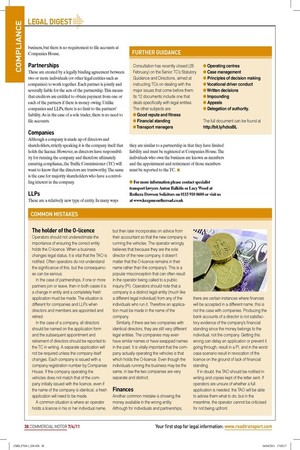COMMON MISTAKES The holder of the O-licence
Page 27

If you've noticed an error in this article please click here to report it so we can fix it.
Operators should not underestimate the importance of ensuring the correct entity holds the O-licence. When a business changes legal status, it is vital that the TAO is notified. Often operators do not understand the significance of this, but the consequences can be serious.
In the case of partnerships, if one or more partners join or leave, then in both cases it is a change in entity and a completely fresh application must be made. The situation is different for companies and LLPs when directors and members are appointed and retired.
In the case of a company, all directors should be named on the application form and the subsequent appointment and retirement of directors should be reported to the TC in writing. A separate application will not be required unless the company itself changes. Each company is issued with a company registration number by Companies House. If the company operating the vehicles does not match that of the company initially issued with the licence, even if the name of the company is identical, a fresh application will need to be made.
A common situation is where an operator holds a licence in his or her individual name, but then later incorporates on advice from their accountant so that the new company is running the vehicles. The operator wrongly believes that because they are the sole director of the new company, it doesn’t matter that the O-licence remains in their name rather than the company’s. This is a popular misconception that can often result in the operator being called to a public inquiry (PI). Operators should note that a company is a distinct legal entity (much like a different legal individual) from any of the individuals who run it. Therefore an application must be made in the name of the company.
Similarly, if there are two companies with identical directors, they are still very different legal entities. The companies may even have similar names or have swapped names in the past. It is vitally important that the company actually operating the vehicles is that which holds the O-licence. Even though the individuals running the business may be the same, in law the two companies are very separate and distinct.
Finances
Another common mistake is showing the money available in the wrong entity. Although for individuals and partnerships, there are certain instances where finances will be accepted in a different name, this is not the case with companies. Producing the bank accounts of a director is not satisfactory evidence of the company’s financial standing since the money belongs to the individual, not the company. Getting this wrong can delay an application or prevent it going through, result in a PI, and in the worst case scenario result in revocation of the licence on the ground of lack of financial standing.
If in doubt, the TAO should be notified in writing and copies kept of the letter sent. If operators are unsure of whether a full application is needed, the TAO will be able to advise them what to do, but in the meantime, the operator cannot be criticised for not being upfront.

















































